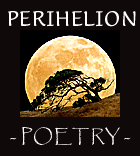Winter Flower
by Billy Howell-SinnardThe Waters
First Place, January 2021
Judged by Nicole Greaves
December sunset, all-day grey turns
faded pink at the edges like a washed-
out peony drooping, barely above ground.
So early, as if day is pruned before it
blooms. Night reigns for a few months.
Days wander between dark and half-
light. Ambivalent, I lie late in bed like a
dead flower pressed in a book. If there’s
a winter flower, it’s the moon—white,
burning in the cold, dark brew of sky
like an iceberg floating in a crystal
bowl of stars, the sun’s dormant self.
In “Winter Flower,” the poet captures the dichotomy of winter, the quality of stasis in juxtaposition to the life it hibernates. From the first lines, it locks the reader in that space through syntax and imagery. The reader knows immediately it is “December,” but the color, even if faint, edges in, permeating like light under a door. The rhyme and single-syllables in “all-day grey turns” eyes us into the needle of time with its ticking, a heartbeat flushed into the “peony” that appears just above the surface. We move back and forth in the poem's tercets, in this tension. In the second stanza, the fragmentation of “So early, as if the day is pruned before it / blooms,” quickly turns to night. In the third stanza, the “I” appears as a “dead flower pressed in a book” like a memory, which reinforces that state of winter. Then there is a marvelous leap of the moon becoming a “flower,” stone turning to life, the “eye” or “I” itself burning in perhaps the poem's best image: “dark brew of sky.” The domestic quality throughout the poem awakens in the last stanza, with this “dark brew” and contrasting “crystal bowl of stars.” The poem conjures Plath’s poem “Wintering,” where Plath putters about in this dichotomy of winter, its isolation. In Plath’s poem, we have the “honey” and persistent “bees,” and here we have the “sun” and the “flowers,” and in both the “I” keeping spring intact. In "Winter Flower," the sun returns, still “dormant,” but returns through its utterance in the last line, like the bees tasting spring in “Wintering.” There is life yet. --Nicole Greaves

